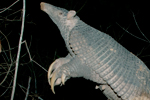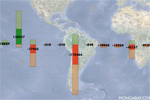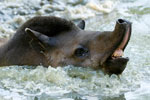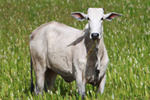Ordinarily, invasive and exotic species are a grave threat to native wildlife: outcompeting local species, introducing parasites and disease, and disturbing local ecological regimes. A unique case in the Brazilian Pantanal, however, has turned the tables; here, an introduced mammal has actually aided the conservation of native wildlife.
The impact of feral pigs (Sus scrofa) is a serious threat to biodiversity in many ecosystems around the globe. Their destructive rooting behavior and voracious appetite are often severely damaging to populations of plants and small animals, not to mention they serve as a reservoir for a host of zoonotic diseases. In the Pantanal, however, introduced feral pigs have had a positive impact on wildlife communities and the local culture.
The Pantanal region of South America, which extends beyond Brazil into Bolivia and Paraguay, is one of the largest freshwater wetlands on the planet and boasts a diversity of unique wildlife- but this hasn’t always been the case.
Previously, commercial bush meat hunting was a somber threat to biodiversity in the Pantanal. Prohibitive legislation changed that in 1967, banning commercial and recreational hunting and extinguishing the pelt and skin trade.
.600.jpg)
Feral pig in the Pantanal. Photo courtesy of Arnaud Desbiez.
The introduction of feral pigs (about 200 years ago) relieved a significant amount of hunting pressure on native species, allowing populations a chance to rebound after the legislation. Pantanal denizens prefer to hunt pigs as opposed to native wildlife because they are abundant, easily accessible, and provide a substantial amount of meat and oil. Pig hunting has become an important part of Pantanal culture.
In addition to a reliable source of protein, pigs provide oil and fat which is used for cooking and curing meat. This valuable resource is important in a place where resources are limited and preserving food is vital.
 Harvesting pig fat. Photo courtesy of Arnaud Desbiez. |
Arnaud Desbiez, the Regional Coordinator of Conservation and Research at the Royal Zoological Society of Scotland, has been studying feral pigs in the Pantanal for some time. Along with his colleague, Alexine Keuroghlian with the Wildlife Conservation Society-Brazil, Desbiez interviewed local hunters about their hunting practices and found that 93% of respondents preferred to hunt feral pigs as opposed to native wildlife, such as collared and white-lipped peccaries, other members of the swine family.
Local hunters are even managing the feral pig population to their advantage, capturing young male pigs, castrating them, and releasing them so that they can grow, gain weight, and be optimal hunting targets when they reach adulthood.
“Feral pigs are hunted on horse[back] with dogs…this means that the young are often separated from their mother and will die of hunger or through predation,” he told mongabay.com.
This human-induced mortality, paired with natural, seasonal effects, is helping to keep the pig population stable.
Although population models show that feral pigs can withstand high hunting pressures, the low survival rates of young and juvenile pigs maintains the population at sustainable levels.
What is more worrisome for pigs are seasonal floods, he remarks “floods strongly affect the availability of their resources.”
Currently, it would appear that the hunting of feral pigs, an exotic species, is a win-win situation for both residents and native wildlife in the Pantanal. This is, of course, provided that the pig population continues to be regulated by hunting activity. If pig harvesting is abandoned, an increased feral pig population could alter community dynamics of native wildlife. Luckily for native peccaries, however, competition from feral pigs is not enough to endanger their populations. In another study, Desbiez and colleagues illustrated that the niche of feral pigs does not significantly overlap with that of native peccaries so they are not directly competing for the same resources.
The detrimental effects of invasive species have been extremely well-documented with acute effects on ecosystems and species around the globe: invasive cane toads in Australia, European starlings in North America, brown tree snakes in Guam, eastern gray squirrels in Europe, and Africanized honey bees in South America. But not all invasive stories end sour.
.360.jpg) Pantanal cook preparing several dishes out of feral pig. Photo courtesy of Arnaud Desbiez. |
Atypical invasive success stories such as this one are becoming more common. Scientists are recognizing the beneficial effects of some exotic species. In Pennsylvania, for example, populations of songbirds have increased due to additional food resources from introduced fruiting trees and vines. In Puerto Rico, degraded land has been colonized by exotic species of trees that have expedited the process of succession, allowing land to be restored more quickly and providing habitat for native wildlife in the process.
This begs a new perspective on invasive species management. Conventionally, the response to an alien species invasion, if caught soon enough, is eradication. This is based on the premise that exotic species, as aliens to their colonized locality, do not belong there and will disrupt the local ecology of the ecosystem. While this has often been the most prudent strategy, the increased rate at which invasives are invading, and the likelihood that it will continue to increase due to human activity, indicates that a new approach may be in order.
Scientists are acknowledging that exotic species are not all hazardous, and may even be beneficial in some circumstances. From this acknowledgement a new paradigm has been suggested: conciliation biology. A recent paper in the journal of Evolutionary Applications by Dr. Scott Carroll from the Institute of Contemporary Evolution encourages conservation biologists and natural resource managers to consider the ecological benefits of exotic species before turning to eradication.
In cases like feral pigs in the Pantanal, beneficial effects on ecosystems, livelihoods, and culture may outweigh the orthodox strategy of eradicating invasives.
CITATIONS: Carroll, S. P. 2011. Conciliation biology: the eco-evolutionary management of permanently invaded biotic systems. Evolutionary Applications 4(2):184-199.
Arnaud Leonard Jean Desbiez, Alexine Keuroghlian, Ubiratan Piovezan and Richard Ernest Bodmer. Invasive species and bushmeat hunting contributing to wildlife conservation: the case of feral pigs in a Neotropical wetland. Oryx. Volume 45. Issue 01. January 2011, pp 78-83.
Related articles
Scientists document baby giant armadillo for first time (photos)

(02/19/2013) Despite weighing as much as full-grown human, almost nothing is known about the giant armadillo (Priodontes maximus) including its breeding and reproductive behaviors. How does mating occur? How long does pregnancy last? How many babes are typically born? Scientists are simply in the dark, but a ground-breaking study employing camera traps is beginning to change this. For the first time, scientists in the Brazilian Pantanal have documented giant armadillo breeding and the happy outcome: a baby giant armadillo.
Can ranchers co-exist with jaguars?

(01/17/2013) Jaguar once roamed from the United States to Argentina, but today they’ve been eliminated from several range countries, including the United States. The chief reasons are habitat loss and direct killing by humans, putting ranchers and farmers at the heart of the issue. Both ranchers and farmers convert key jaguar habitat and kill the big cats as a threat to their livestock. However in parts of Brazil’s Pantanal, some ranchers are going about their business without killing jaguars. My Pantanal, a film by Andrea Heydlauff, Vice President of the wild cat conservation group Panthera, takes a look at one particular ranch that is helping prove that jaguars and ranchers can co-exist.
Cute picture of the day: armadillo carrying baby
(09/19/2012) A rare image of a female six-banded armadillo (Euphractus sexcinctus) moving her image was captured by the Embiara Lodge in Brazil’s Pantanal.
Flooded savannas in Latin America shrinking 3 times faster than rainforests
(08/22/2012) Flooded grasslands and savannas in Latin America are disappearing nearly three times faster than tropical rainforests in the region, finds a new study published in the journal Biotropica.
Chart: Forest loss in Latin America

(08/20/2012) Latin America lost nearly 260,000 square kilometers (100,000 square miles) of forest — an area larger than the state of Oregon — between 2001 and 2010, finds a new study that is the first to assess both net forest loss and regrowth across the Caribbean, Central and South America. The study, published in the journal Biotropica by researchers from the University of Puerto Rico and other institutions, analyzes change in vegetation cover across several biomes, including forests, grasslands, and wetlands. It finds that the bulk of vegetation change occurred in forest areas, mostly tropical rainforests and lesser-known dry forests. The largest gains in biome area occurred in desert vegetation and shrublands.
Brazil’s environmental leadership at risk, warn scientists
(06/26/2012) The Brazilian government is putting its global environmental leadership at risk by ignoring scientific concern on large infrastructure projects and changes in the country’s forest laws, warned an association of more than 1,200 tropical scientists gathering last week in Bonito, Brazil on the heels of the disappointing Rio+20 Earth Summit.
Protecting jaguars a good business decision for ranchers
(06/20/2012) Live jaguars are worth considerably more for ecotourism than they livestock they kill, according to a study presented at the annual meeting of the Association for Tropical Biology and Conservation in Bonito, Brazil.
Loving the tapir: pioneering conservation for South America’s biggest animal

(09/11/2011) Compared to some of South America’s megafauna stand-out species—the jaguar, the anaconda, and the harpy eagle come to mind—the tapir doesn’t get a lot of love. This is a shame. For one thing, they’re the largest terrestrial animal on the South American continent: pound-for-pound they beat both the jaguar and the llama. For another they play a very significant role in their ecosystem: they disperse seeds, modify habitats, and are periodic prey to big predators. For another, modern tapirs are some of the last survivors of a megafauna family that roamed much of the northern hemisphere, including North America, and only declined during the Pleistocene extinction. Finally, for anyone fortunate enough to have witnessed the often-shy tapir in the wild, one knows there is something mystical and ancient about these admittedly strange-looking beasts.
How to save the Pantanal and increase profits for the cattle industry

(03/28/2011) The Pantanal spanning Brazil, Bolivia, and Paraguay is the world’s largest wetland—the size of Florida—and home to a wide-variety of charismatic species, such as jaguars, capybaras, and giant anteaters. However, the great wetland is threatened by expansion in big agriculture and an increasingly intensive cattle industry. Yet there is hope: a new study by Wildlife Conservation Society of Brazil (WCS-Brazil) researchers has found that cattle and the ecosystem can exist harmoniously. By replacing current practices with rotational grazing, cattle ranchers gain a healthier herd and more profits while safeguarding the ecological integrity and wildlife of the world’s largest wetland system. The study published in mongabay.com’s open access journal Tropical Conservation Science is a rare instance of a win-win situation.